Description of Cam-Clay and Modified-Cam-Clay Critical State Strength Models
Introduction
The first critical state models for describing the behaviour of soft soils such as clay, the Cam-Clay (CC) and
Modified Cam-Clay (MCC) were formulated by researchers at Cambridge University. Both models describe three
important aspects of soil behaviour:
(i)
(ii)
(iii)
Strength
Compression or dilatancy (the volume change that occurs with shearing)
Critical state at which soil elements can experience unlimited distortion without any changes in stress or
volume.
A large proportion of the volume occupied by a soil mass consists of voids that may be filled by fluids (primarily air
and water). As a result, deformations in soil are accompanied by significant, and often non-reversible, volume
changes. A major advantage of cap plasticity models, a class to which the CC and MCC formulations belong, is their
ability to model volume changes more realistically.
The primary assumptions of the CC and MCC models are described next. In critical state mechanics, the state of a
soil sample is characterized by three parameters:
• Effective mean stress
• Deviatoric (shear stress) q , and
• Specific volume ν.
'p
Under general stress conditions, the mean stress,
principal stresses
2σ and
3σ as
'
'
'
1σ ,
)
(
'
σ σ σ
3
+
+
'
1
'
2
'p , and the devaitoric stress, q , can be calculated in terms of
'
p
=
q
=
1
3
1
2
(
'
σ σ
2
−
'
1
2
)
+
(
'
σ σ
3
−
'
2
2
)
+
(
'
σ σ
1
−
'
3
2
)
'
2
'
=
)
'
1
=
=
'
p
ln p
'
ν= + , where e is the void ratio.
1 e
The specific volume is defined as
Virgin Consolidation Line and Swelling Lines
The models assume that when a soft soil sample is slowly compressed under isotropic stress conditions
(
, and under perfectly drained conditions, the relationship between specific volume, ν, and
'
σ σ σ
3
consists of a straight virgin consolidation line (also known as the normal compression line) and a set of straight
swelling lines (see Figure 1). Swelling lines are also called unloading-reloading lines.
The loading and unloading behaviour of the CC and MCC models is best described with an example. When a soil
, it moves down the virgin consolidation line
element is first loaded to isotropic stress
from point a to point b. If the sample is unloaded the specific volume–mean stress behaviour moves up the swelling
line bc to the point c.
If the sample is now reloaded to a stress
Once
then unloaded to a stress value of
The virgin consolidation line in Figure 1 is defined by the equation
v
while the equation for a swelling line has the form
v
The values λ, κ and N are characteristic properties of a particular soil. λ is the slope of the normal compression
(virgin consolidation) line on
bp is exceeded, the sample will again move down the virgin consolidation line to the point d. If the sample is
plane, while κ is the slope of swelling line. N is known as the specific
dp , it will first move down the swelling line for stress values up to
ap , this time it will move up the swelling line de .
bp , on the plane of
pκ=
ln
pλ=
ln
ln pν
−
p
ln '
bp .
,
v
s
N
.
−
−
−
'
'
v
'
'
′
'
'
�
sv differs for each swelling line, and depends on the loading history of a soil.
volume of normal compression line at unit pressure, and is dependent on the units of measurement. As can be seen
on Figure 1,
If the current state of a soil is on the virgin consolidation (normal compression) line the soil is described as being
normally consolidated. If the soil is unloaded such as is described by the line bc , it becomes overconsolidated. In
general, soil does not exist outside the virgin consolidation line; when it does that state is unstable.
The Critical State Line
Sustained shearing of a soil sample eventually leads to a state in which further shearing can occur without any
changes in stress or volume. This means that at this condition, known as the critical state, the soil distorts at
constant state of stress with no volume change. This state is called the Critical State and characterized by the Critical
q′ − plane the CSL is a straight line passing through the origin with the slope equal to M ,
State Line (CSL). In p
one of the characteristic of the material (see Fig. 3).
The location of this line relative to the normal compression line is shown on Figure 2. As seen in the picture, the
CSL is parallel to the virgin consolidation line in
at unit pressure. Like N , the value of Γ depends on measurement units.
There is a relationship between the parameter N of the normal compression line and Γ . For the Cam-Clay model
the two parameters are related by the equation
Γ =
while for the Modified Cam-Clay model the relationship is
Γ =
Due to this relationship between N and Γ , only one of them needs to be specified when describing a Cam-Clay or
Modified Cam-Cam material.
Yield Functions
The yield functions of the CC and MCC models aree determined from the following equations:
Cam-Clay
space. The parameter Γ is the specific volume of the CSL
N λ κ
)
N λ κ
p
ln '
)ln 2
,
.
−
−
−
−
−
v
(
(
q Mp
+
'
ln
=
0
'
p
'
p
o
Modified Cam-Clay
q M
p
'
op
'
p
+
−
1
'2
2
2
=
0
'
'p
'p
q− space. A key characteristic of the CSL is that it
q− space, the CC yield surface is a logarithmic curve while the MCC yield surface plots as an elliptical curve
op (known as the yield stress or pre-consolidation pressure) controls the size of the yield
In
(Figure 3). The parameter
surface. The parameter M is the slope of the CSL in
intersects the yield curve at the point at which the maximum value of q is attained.
In three-dimensional space
Boundary Surface. The State Boundary Surface for the Modified Cam-Clay model is shown in Figure 4.
− the yield surface defined by the CC or MCC formulation is known as the State
−
p
q
v
'
�
Elastic Material Constants for Cam-Clay and Modified Cam-Clay
In geotechnical engineering, the elastic material constants commonly used to relate stresses to strains are Young’s
modulus, E , shear modulus, G , Poisson’s ratio, µ, and bulk modulus, K . Only two of these parameters must be
specified in an analysis.
In soil modelling, the more fundamental elastic parameters of shear modulus, G , and bulk modulus, K , are
preferred. This is because they allow the effects of volume change and distortion to be decoupled.
For Cam-Clay and Modified Cam-Clay soils, the bulk modulus is not constant. It depends on mean stress,
specific volume, ν, and the slope of the swelling line, κ, and is calculated as
K
Cam-Clay and Modified Cam-Clay formulations require specification of either shear modulus G or Poisson’s ratio
µ. When G is given as a constant then µ is no longer a constant, and is calculated from the equation
=
µ
vp
κ
'p ,
=
.
K
3
G
2
−
+
G
2
K
6
When µ is given as a constant then G is determined using the relationship
G
K
=
3(1 2 )
µ
−
2(1
)
+
µ
'p ), specific volume, ν, and
op (also known as preconsolidation pressure is a measure of the highest stress level the soil has ever
The Overconsolidation Ratio
The current state of a soil can be described by its stress state (mean effective stress
yield stress,
experienced). The ratio of preconsolidation pressure to current mean effective stress is known as the
overconsolidation ratio (OCR), i.e.
OCR
=
.
op
'
p
The in-situ distribution of preconsolidation pressure for a Cam-Clay or Modified Cam-Clay material can be
generated using the OCR. An OCR value of 1 represents a normal consolidation state; a state in which the
maximum stress level previously experienced by a material is not larger than the current stress level. OCR > 1
describes an overconsolidated state indicating that the maximum stress level experienced by the material is larger
than the present stress level.
Hardening and Softening Behaviour
If yielding occurs to the right of the point at which the CSL intersects a yield surface, hardening behaviour,
accompanied by compression, is exhibited. This side of the yield surface is known as the wet or subcritical side.
Figure 5a illustrates the soil behaviour on the wet side for the case of simple shearing. When a sample is sheared, it
behaves elastically until it hits the initial yield surface. From then on the yield surface begins to grow/expand and
exhibits hardening behaviour (yielding and plastic strain is accompanied by an increase in yield stress). The figure
shows two intermediate growth stages of the yield surface. At the point C, the sample reaches critical state at which
it will continue to distort without any accompanying changes in shear stress or volume. Figure 5b portrays the stress-
strain hardening behaviour that occurs for the sample loaded on the wet side.
If yielding occurs to the left of the intersection of the CSL and yield surface (called the dry or supercritical side), the
soil material exhibits softening behaviour, which is accompanied by dilatancy (increase in volume). In softening
regimen the yield stress curve decreases after the stress state touches the initial envelope. To depict the reduction in
yield stress curve, the loading line in Figure 6a doubles back. The yield curve and sustained load move downwards
�
until the sample comes to the critical state. The softening stress-strain curve for dry side loading is shown on Figure
6b.
Specification of Initial States for Cam-Clay and Modified Cam-Clay Models
To compute models involving Cam-Clay or Modified Cam-Clay materials, non-trivial initial effective stresses must
be specified. Phase2 allows specification of gravity in-situ stresses or a constant stress field.
Next, the initial state of consolidation (initial yield surfaces for all stress states) must be specified. This can be done
in one of two ways:
(a) Specification of the OCR, or
(b) Specification of a pre-consolidation stress,
op
If a current stress state completely lies within a specified yield surface, the soil will initially respond elastically to
loading. This implies that it is overconsolidated. If, however, the initial stress state is located on the yield surface, the
soil will respond elasto-plastically upon loading, indicating that it is normally consolidated.
Since initial stress states that lie outside yield surfaces have no physical meaning for Cam-Clay and Modified Cam-
Clay models, Phase2 will not allow them. If such stress states are specified, Phase2 will change the pre-consolidation
stress to a value (see below) that makes the soil normally consolidated. If in a model an initial mean effective
pressure is negative, Phase2 warn about the occurrence and will not compute the model.
Specification of Initial Consolidation State for Gravity Loading
Case I: When OCR is specified
(a) Determine vertical stress distribution,
(b) Determine horizontal stresses,
(c) For each element, calculate mean effective stress,
(d) Calculate pre-consolidation pressure,
'vσ
'hσ , using
oK
op , such that
*
'p , and deviatoric stress, q
(
F p q p =
0
)*
',
,
o
For Cam-Clay:
*
op
=
p e
'
q
Mp
'
For Modified Cam-Clay:
*
p
o
=
2
q
2
M p
'
+
p
'
(e) Set initial element pre-consolidation pressure,
op , equal to
p
o
=
*
p OCR
o
⋅
(f) Set initial element specific volume,
initv
, to be consistent with
op and the specified parameters M, λ, and κ
v
init
=
N
−
ln
λ
p
o
−
κ
ln
'
p
p
o
Case II: When pre-consolidation pressure,
op , is initially specified
(a) Determine vertical stress distribution,
(b) Determine horizontal stresses,
(c) For each element, calculate mean effective stress,
(d) Calculate pre-consolidation pressure
op such that
'vσ
'hσ , using
oK
*
'p , and deviatoric stress, q
(
F p q p =
0
)*
',
,
o
For Cam-Clay:
*
op
=
p e
'
q
Mp
'
For Modified Cam-Clay:
*
p
o
=
2
q
2
M p
'
+
p
'
(e) Set initial element pre-consolidation pressure,
op , equal to
p
o
=
max
*
p p
o
,
o specified
,
(
)
(f) Set initial element specific volume,
initv
, to be consistent with
op and the specified parameters M, λ, and κ
�
v
init
=
N
−
ln
λ
p
o
−
κ
ln
'
p
p
o
Specification of Initial Consolidation State for Constant In-situ Stress Field
The specification of initial states for a constant stress field is the same as for gravity loading except that initial
effective vertical and horizontal stresses do not have to be determined.
Summary of Input Parameters for Cam-Clay and Modified Cam-Clay Materials
Specification of Cam-Clay and Modified Cam-Clay models requires five material parameters. These parameters are
outlined below.
1. λ – the slope of the normal compression (virgin consolidation) line and critical state line (CSL) in
p
ln '
−
v
space
2. κ – the slope of a swelling (reloading-unloading) line in
3. M – the slope of the CSL in
space
p−
q
'
v
−
p
ln '
space
N – the specific volume of the normal compression line at unit pressure
or
Γ – the specific volume of the CSL at unit pressure
4.
µ – Poisson’s ratio
or
G – shear modulus.
5.
The initial state of consolidation of such materials must also be specified. This is accomplished by indicating
the preconsolidation pressure.
OCR – the overconsolidation ratio: the ratio of the previous maximum mean stress to the current mean stress
or
op –
Remark on the application of Cam-Clay and Modified Cam-Clay models in FE analyses:
The Cam-Clay and Modified Cam-Clay models may allow for unrealistically large ratios of shear stress over mean
stress when the stress state is above the critical state line. Furthermore, these models predict a softening behaviour
for the state of stress on the dry side of the yield surface. Without special considerations, the softening behaviour
leads to mesh dependency of a finite element analysis. The use of these two models in simulations of practical
applications including general boundary valued problems is not recommended.
�
v
N
vs1
vs2
a
c
e
λ
κ
1
1
Virgin consolidation line
(Normal compression line)
Swelling lines
b
d
pd
ln p
1
pb
Figure 1. Behaviour of soil sample under isotropic compression.
v
N
Γ
Virgin compression
li
CSL
Figure 2. Location of CSL relative to virgin compression line.
ln
�
q
Critical State Line
(CSL)
1
M
Modified Cam-Clay (MCC)
yield curve
Cam-Clay (CC)
yield curve
p
po
Figure 3. Cam-Clay and Modified Cam-Clay yield surfaces (in
CSL.
'
p
'
q− ) space. The parameter M is the slope of the
�
CSL
q
State boundary
surface
p
v
p
Figure 4. The State Boundary Surface for the Modified Cam-Clay model.
�
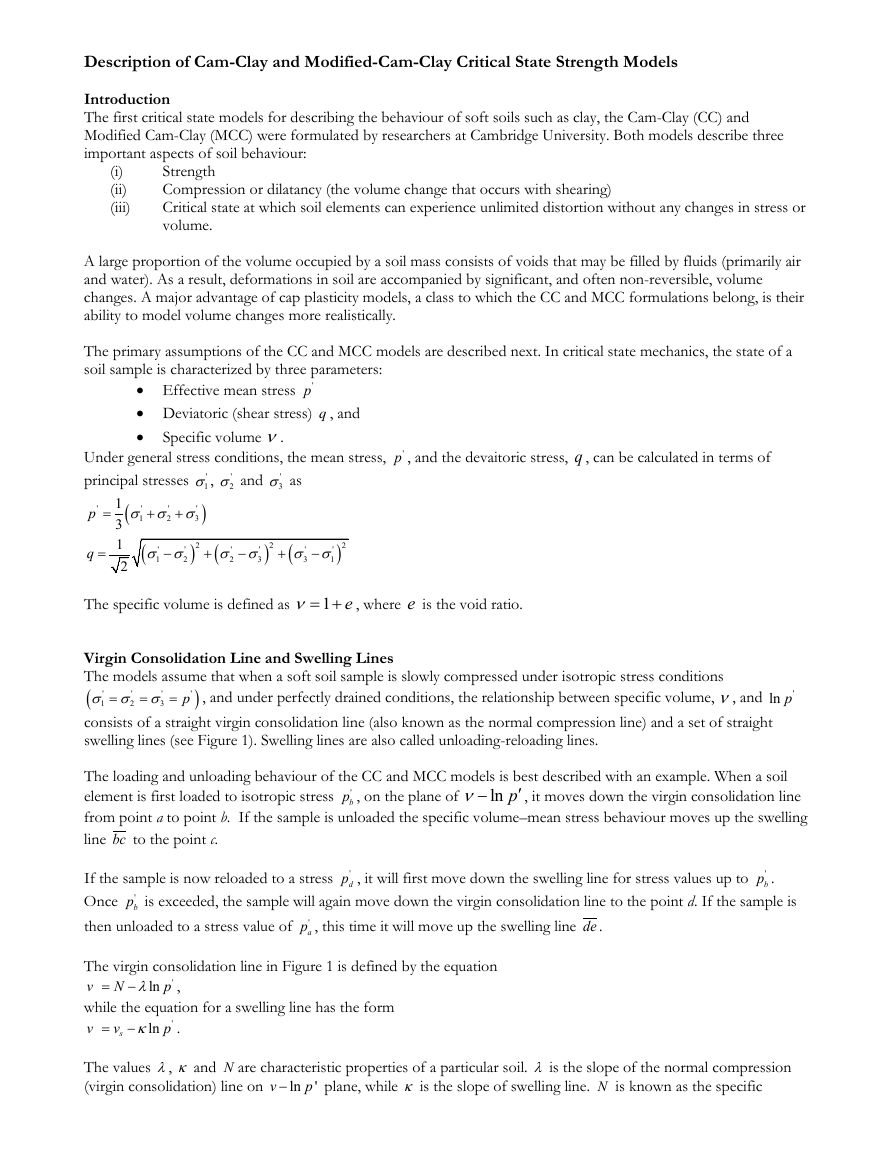
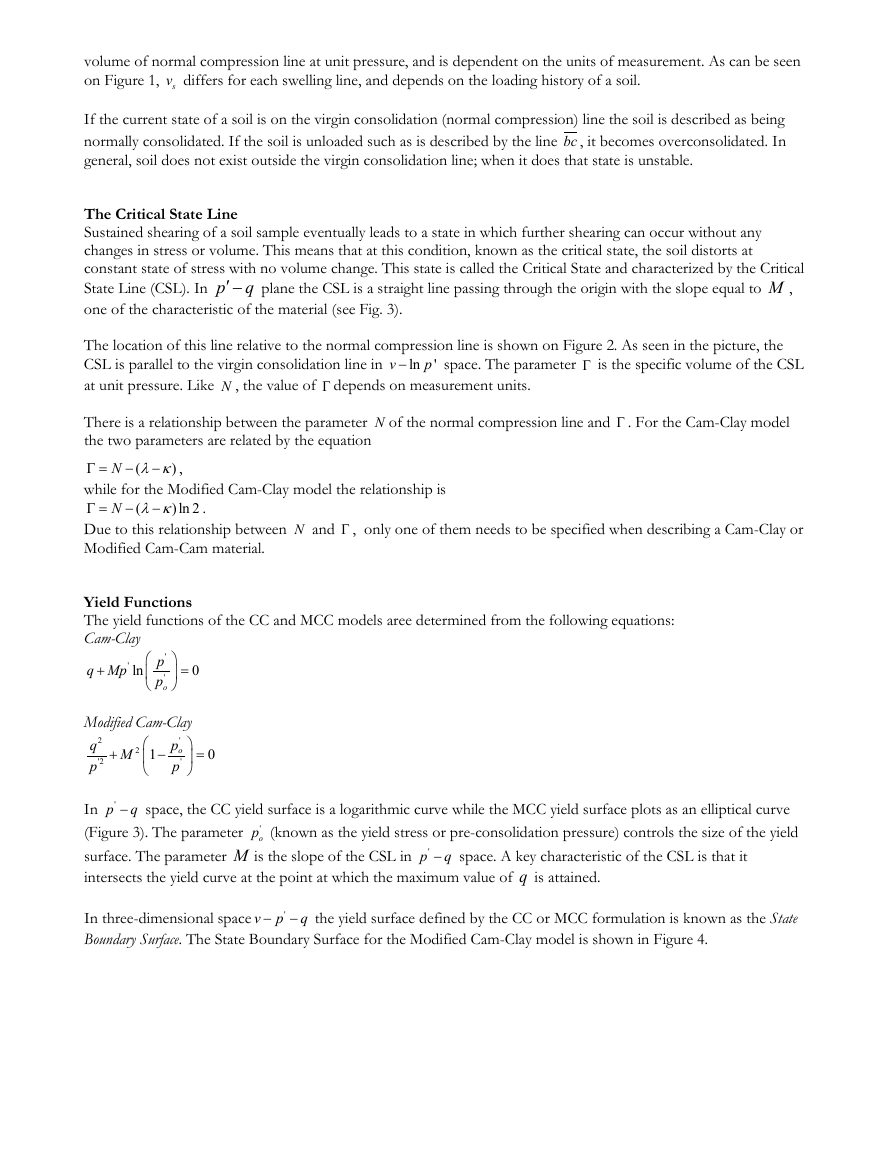
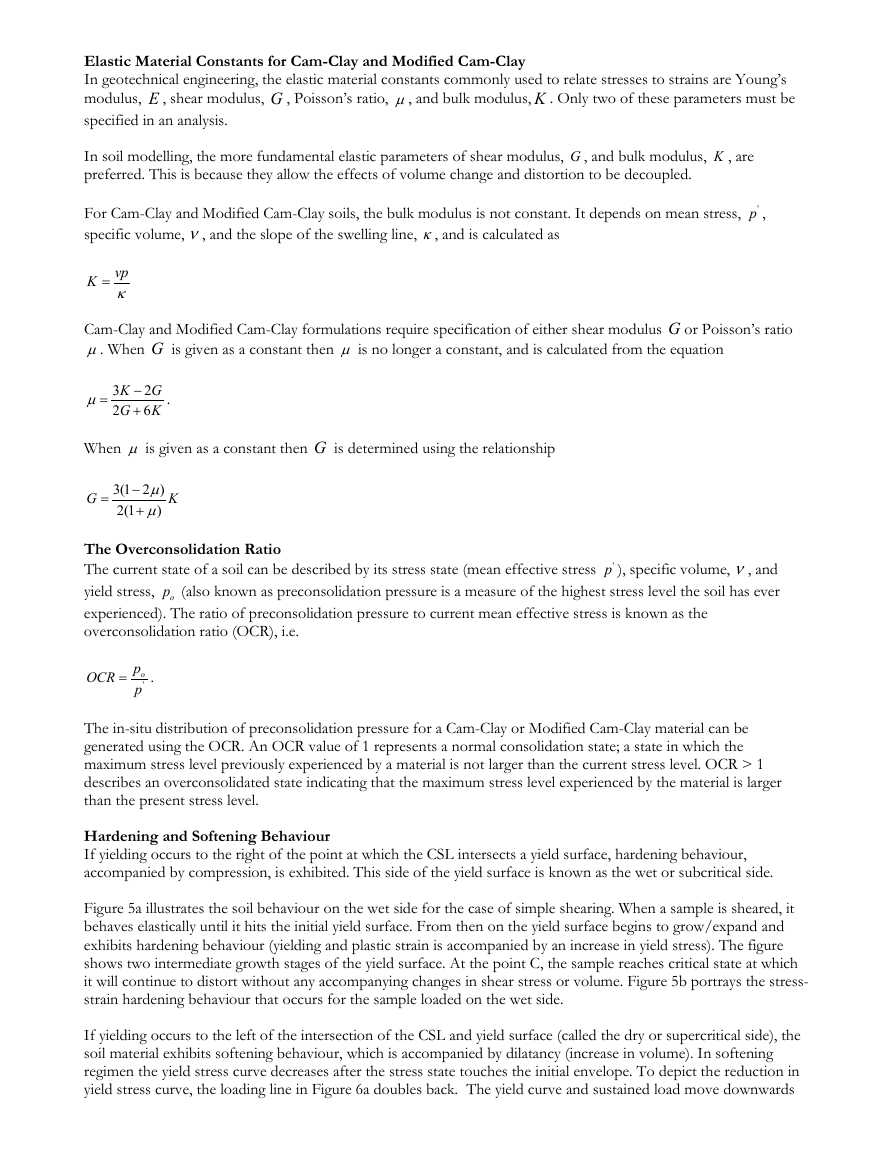
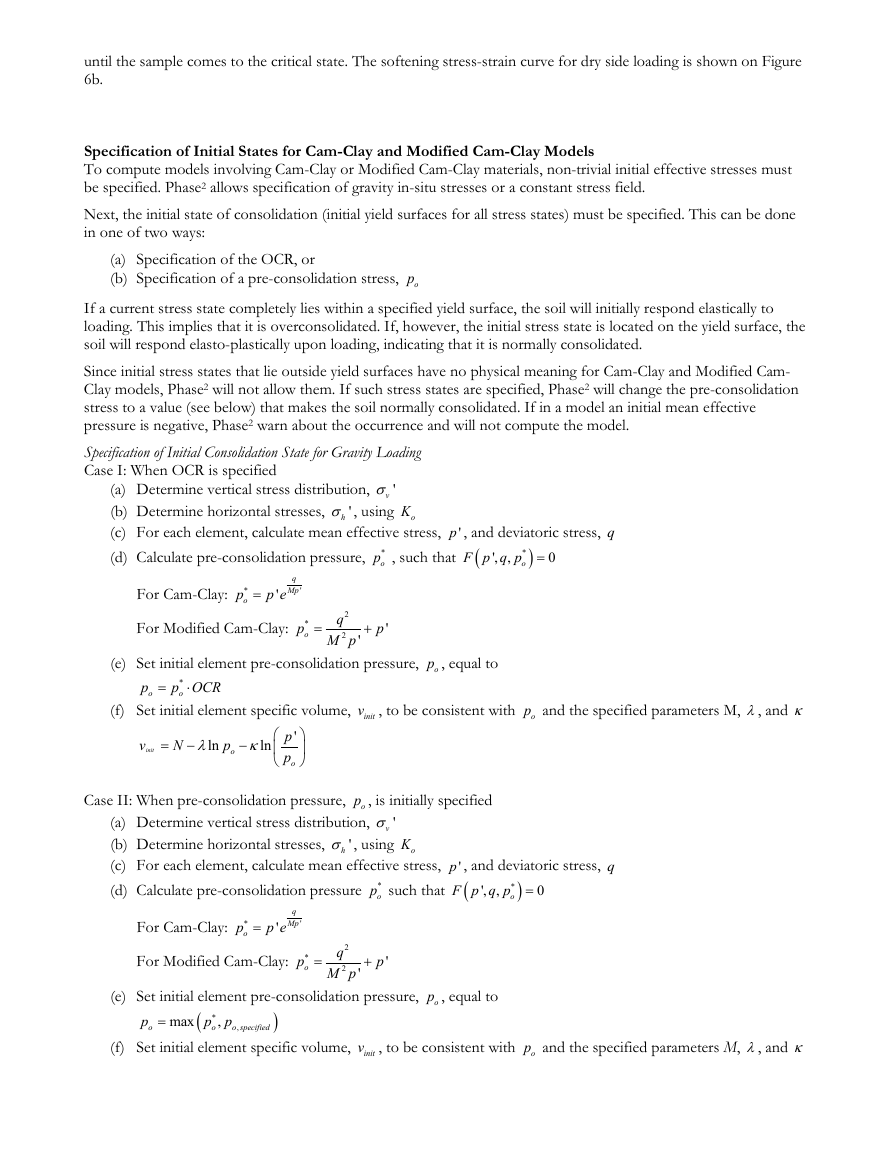

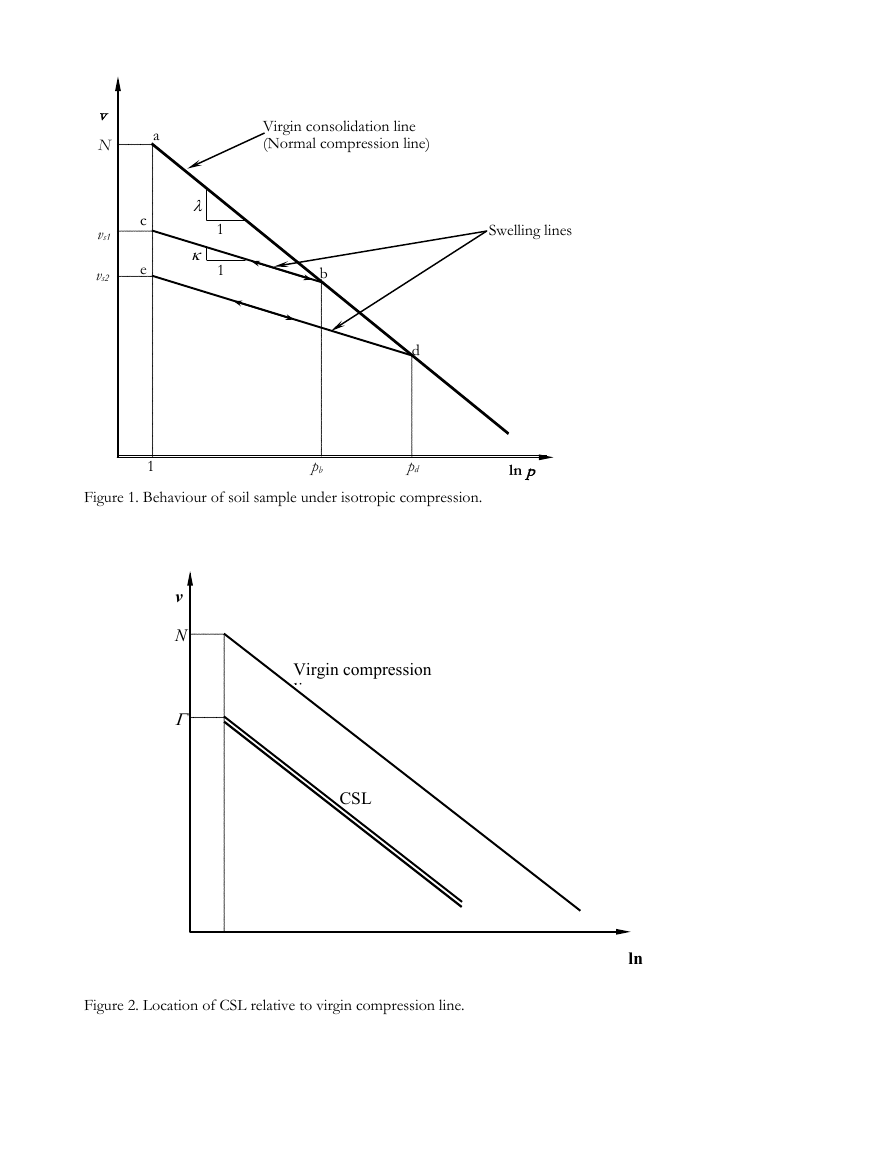
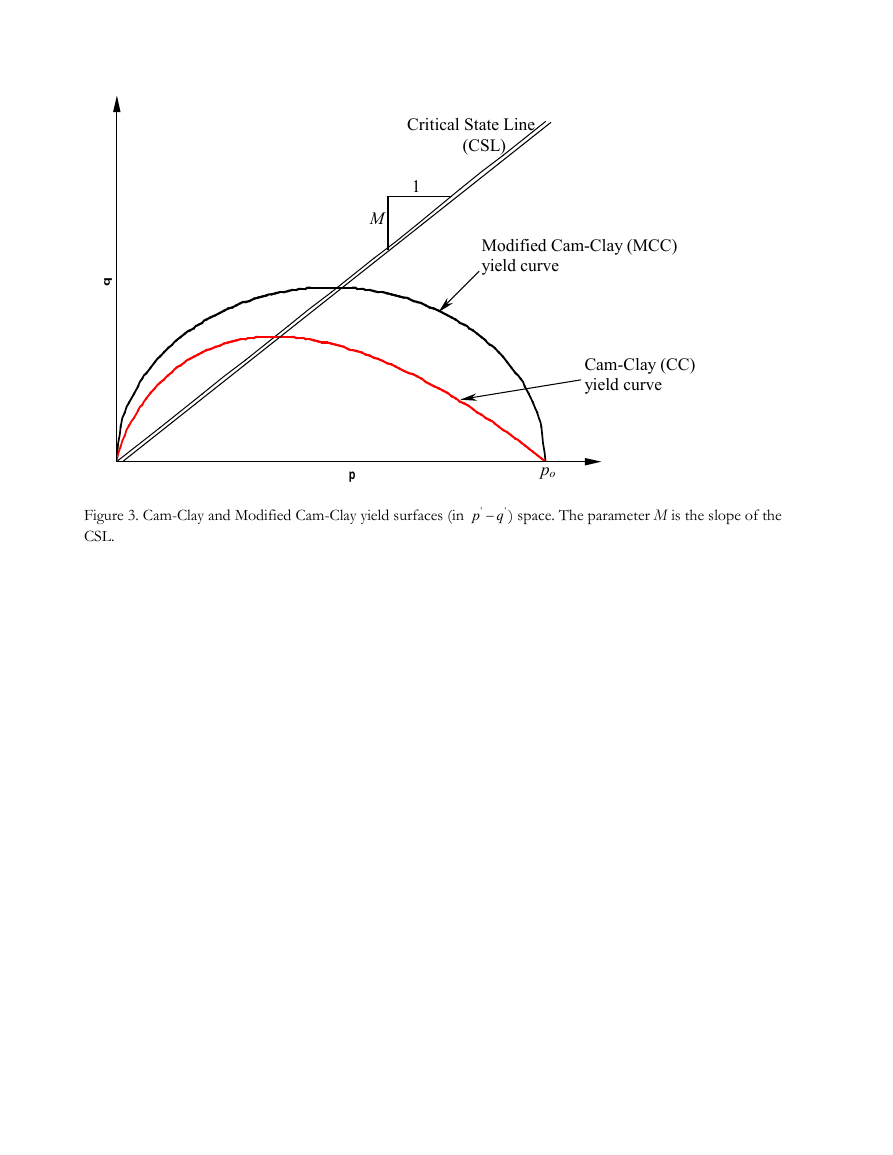
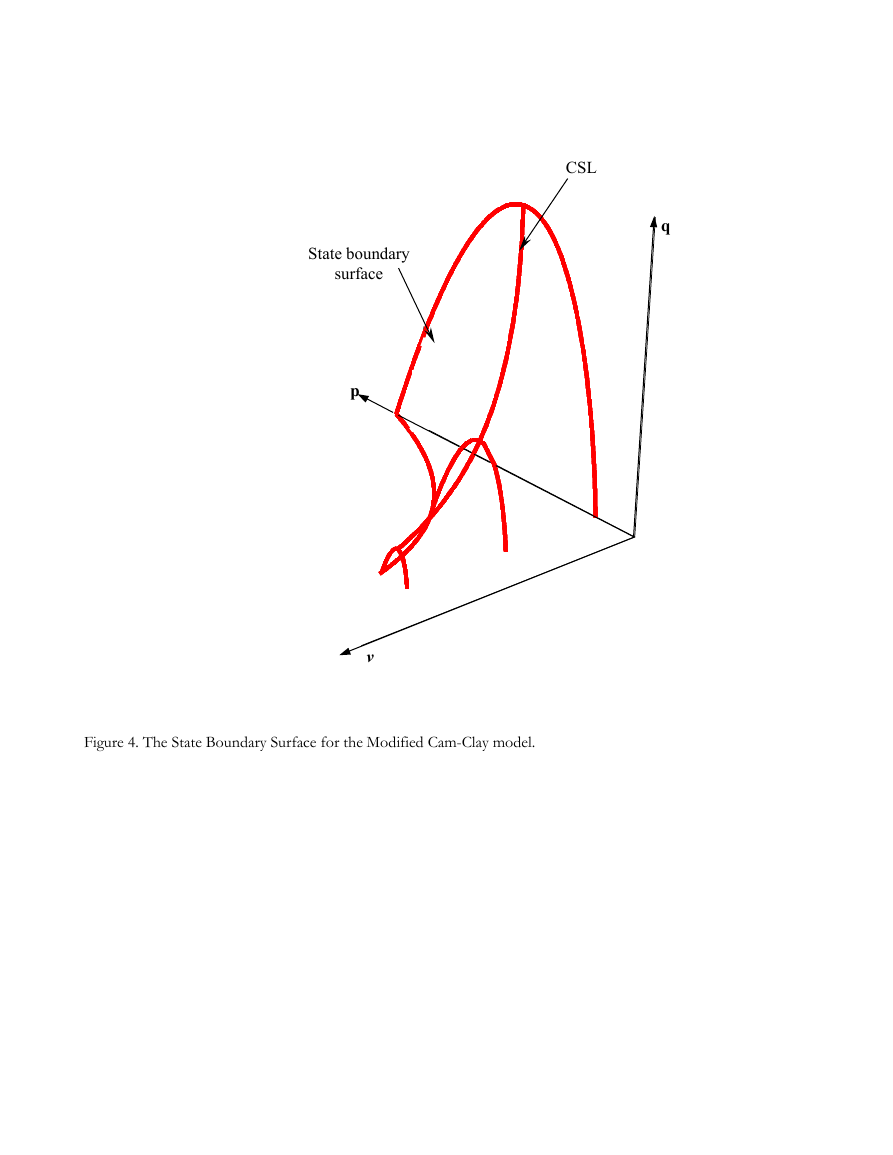








 2023年江西萍乡中考道德与法治真题及答案.doc
2023年江西萍乡中考道德与法治真题及答案.doc 2012年重庆南川中考生物真题及答案.doc
2012年重庆南川中考生物真题及答案.doc 2013年江西师范大学地理学综合及文艺理论基础考研真题.doc
2013年江西师范大学地理学综合及文艺理论基础考研真题.doc 2020年四川甘孜小升初语文真题及答案I卷.doc
2020年四川甘孜小升初语文真题及答案I卷.doc 2020年注册岩土工程师专业基础考试真题及答案.doc
2020年注册岩土工程师专业基础考试真题及答案.doc 2023-2024学年福建省厦门市九年级上学期数学月考试题及答案.doc
2023-2024学年福建省厦门市九年级上学期数学月考试题及答案.doc 2021-2022学年辽宁省沈阳市大东区九年级上学期语文期末试题及答案.doc
2021-2022学年辽宁省沈阳市大东区九年级上学期语文期末试题及答案.doc 2022-2023学年北京东城区初三第一学期物理期末试卷及答案.doc
2022-2023学年北京东城区初三第一学期物理期末试卷及答案.doc 2018上半年江西教师资格初中地理学科知识与教学能力真题及答案.doc
2018上半年江西教师资格初中地理学科知识与教学能力真题及答案.doc 2012年河北国家公务员申论考试真题及答案-省级.doc
2012年河北国家公务员申论考试真题及答案-省级.doc 2020-2021学年江苏省扬州市江都区邵樊片九年级上学期数学第一次质量检测试题及答案.doc
2020-2021学年江苏省扬州市江都区邵樊片九年级上学期数学第一次质量检测试题及答案.doc 2022下半年黑龙江教师资格证中学综合素质真题及答案.doc
2022下半年黑龙江教师资格证中学综合素质真题及答案.doc